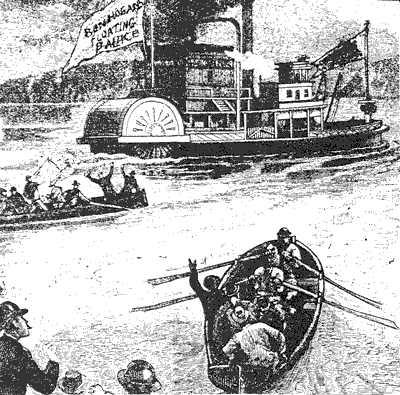 |
||||||
Oil Country Stories
Having read Hogan’s biography (1878), Asbury’s chapters “Sin Among the Derrick” and “The Man from Hell” (1942), and comments found in nearly a dozen other sources, it seems to be appropriate to recite a few of the escapades that were carried out by the roughs and witnessed by the oilmen of the day.
Petroleum Centre had three city blocks of whore houses and the like. Tucked among the back street free-and-easies was a gymnasium operated by Professor Johnny Sweeney, a strong man who found the Centre to be a perfect place to give lessons in rough-and-tumble fighting. The Professor was partial to dirty techniques and his clientele soon became adept at ear-biting and other sly maneuvers. The gym’s specialty was the art of EYE-GOUGING. All back-street hellions wanted to be proficient in this type of horrible combat. The best move for those on the defense was to hit first and hard before the opponent’s thumb got anywhere near your face. Petroleum Centre had such a dismal reputation that the Professor’s questionable gymnastics seemed to blend right in.
Ben Hogan’s capers always made news. As mentioned earlier, Hogan had executive ability, a fertile imagination, the drive to put a new project into motion and, in general, the gift of entrepreneurship. Thus equipped, in 1870 he visited the new oil strike at Parkers Landing on the Allegheny River in Armstrong County. There were already some brothels and bars there, but Ben saw the place as ripe for competition. He opened a “sporting” house, but he had a more grandiose plan in mind. A reform wave hit Parker but didn’t deter Hogan (Giddens, 1948). He set about remodeling a river steamer that had seen better days. It was 125 feet long and 30 feet wide, big enough to deserve the name “Ben Hogan’s Floating Palace of Pleasure”. He then brought in a bevy (or two) of soiled doves, hired an orchestra, saw to the larder and an enormous stock of liquor. This was the first resort of its kind in America (Asbury, 1942).
 |
Ben Hogan’s famous Floating Palace, the centerpiece of the celebrated bathing parties, is shown to be a stern wheeler in this illustration. One can see that the customers had already started to party in the rowboats enroute to the Palace. Getting back to shore after a night on board wasn’t always as easy as the trip out. Illustration from Giddens, 1948, Princeton University Press. |
The Floating Palace was anchored in the center of the Allegheny River opposite Parker, and the clientele achieved entry by rowboat which ferried revelers back and forth (mostly forth). The Palace obviously attracted great attention and this included the authorities in Clarion and Armstrong Counties on opposing banks of the river. The LAW in both counties was never synchronized so if a raid appeared imminent by deputies from, say, Armstrong County, Hogan would move the Palace over to the Clarion County side. These dodge-em tactics worked as long as the lookouts didn't get drunk or fall asleep. As a further precaution Ben finally opted to buy a liquor license in Clarion County. The Clarion County Sheriff found this to be legal and furthermore didn’t feel obliged to safeguard the morals of riverbank people or take their complaints seriously. Still, Hogan found it prudent to move his Floating Palace out to the middle and over to the Armstrong side (there were plenty of customers there) from time to time.
Hogan’s Floating Palace had special entertainment scheduled at various times particularly at 5:00 PM every day. It was mandatory BATH TIME in the river for the girls, and Hogan turned it into a hit feature. Men paid well for deck chairs so positioned to allow a good and comfortable view of the proceedings. There were also some hands-on interludes when, for two bucks, a gentleman (or whoever) could jump into the river and assist the bare bathers with their ablutions.
| © 2004, Samuel T. Pees all rights reserved |
|